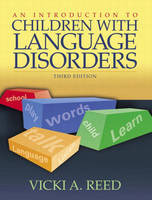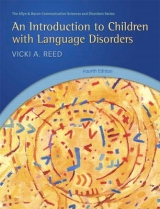
An Introduction to Children with Language Disorders
Pearson (Verlag)
978-0-205-42042-1 (ISBN)
- Titel erscheint in neuer Auflage
- Artikel merken
The new edition of An Introduction to Children with Language Disorders provides an excellent overview of the variety of populations of children who have language disorders.
Authored by Vicki Reed, the third edition has been thoroughly updated and revised. Organized by common childhood language disorder populations, this offers a discussion of language disorders in a wide range of children, which gives this text a depth and breath that's unsurpassed. Coverage encompasses language disorders in children with specific language impairment, mental retardation, autism, learning disabilities, hearing-impairment, and acquired language disorders; language disorders in children from toddler age to adolescence, in bilingual-bicultural children, and, in special populations such as gifted children, children with visual impairment, children with neuromotor problems, and children with cleft palate. This new edition includes excellent coverage of adolescents with language disorders and an explanded and updated chapter on intervention. A new spearate chapter on AAC and its consideration with children with language disorders is also included.
Each chapter concludes with “Summary.” I. ASPECTS OF NORMAL LANGUAGE AND COMMUNICATION
1. Language and Human Communication: An Overview (Vicki A. Reed and Elise Baker).
Communication.
Components of Language.
Comprehension and Production.
Communication Modes.
Biological, Cognitive and Social Bases of Human Communication.
2. Normal Language Development: A Review (Vicki A. Reed and Elise Baker).
The Prelinguistic Period: The First 12 Months.
The First Word Period.
The Period of Two-Word Utterances.
The Preschool Years and Beyond.
Language, Literacy, and Education.
II. CHILDREN WITH LANGUAGE DISORDERS.
3. Toddlers and Preschoolers with Specific Language Impairment.
Identification of Children with Language Impairment.
An Overview of Specific Language Impairment.
Language Characteristics of Children with Specific Language Impairment.
Implications for Intervention.
4. Language and Children with Learning Disabilities (Steven H. Long).
An Overview of Children with Learning Disabilities.
Linguistic Issues Relevant to Learning Disability.
Communication Problems in Children with Learning Disabilities.
Implications for Intervention.
5. Adolescents with Language Impairment.
A Neglected Group with Significant Problems.
Language Development.
Characteristics of Language-Disordered Adolescents.
Assessment.
Intervention.
6. Language and Children with Intellectual Disabilities (Steven H. Long).
An Overview of Intellectual Disabilities.
The Delay-Difference Controversy.
Language Characteristics of Children with Intellectual Disabilities.
Language Characteristics of Children with Down Syndrome.
Implications for Intervention.
7. Language and Children with Autism (Steven H. Long).
An Overview of Children with Autism.
Communication in Children with Autism.
Implications for Intervention.
8. Language and Children with Auditory Impairments (Kerrie Lee).
Overview of Hearing Loss.
Language of Children with Differing Degrees of Hearing Loss and Intervention Implications.
Central Auditory Processing Disorders (CAPD).
Auditory Neuropathy.
9. Language and Linguistically-Culturally Diverse Children (Steven H. Long).
Concepts of Cultural Diversity.
Concepts of Linguistic Variation.
Concepts of Second Language Learning.
Language Characteristics of Linguistically-Culturally Diverse Children.
The Influence of Poverty.
Issues in Assessment.
Implications for Intervention.
10. Children with Acquired Language Disorders (Steven H. Long).
An Overview of Acquired Childhood Aphasia.
Language Development and Language Recovery.
Language Characteristics of Children with Acquired Aphasia.
Academic Achievement.
Differences Between Developmental and Acquired Language Disorders in Children.
Implications for Assessment and Intervention.
11. Language and Other Special Populations of Children (Steven H. Long).
Language and Gifted Children.
Language and Children with Visual Impairment.
Language and Children with Neuromotor Impairment.
Language and Children with Cleft Palate.
III. LANGUAGE INTERVENTION.
12. Language and Augmentative and Alternative Communication (AAC) (Susan Balandin).
What is AAC?
Children Who Benefit from AAC.
Does AAC Prevent Speech Developing?
AAC Assessment.
Facilitated Communication.
13. Assessment.
Approaches to and Objectives of the Assessment Process.
Tools and Procedures.
Intelligence Testing.
14. Considerations for Language Intervention.
Considerations in Intervention.
Highlighting Intervention Targets.
Procedures and Techniques to Facilitate Learning of Language Targets.
Approaches to Intervention.
Putting it Together.
References.
Author Index.
Subject Index.
| Erscheint lt. Verlag | 22.7.2004 |
|---|---|
| Sprache | englisch |
| Maße | 242 x 195 mm |
| Gewicht | 998 g |
| Themenwelt | Medizin / Pharmazie ► Gesundheitsfachberufe ► Logopädie |
| Medizin / Pharmazie ► Medizinische Fachgebiete ► Pädiatrie | |
| ISBN-10 | 0-205-42042-7 / 0205420427 |
| ISBN-13 | 978-0-205-42042-1 / 9780205420421 |
| Zustand | Neuware |
| Haben Sie eine Frage zum Produkt? |
aus dem Bereich



